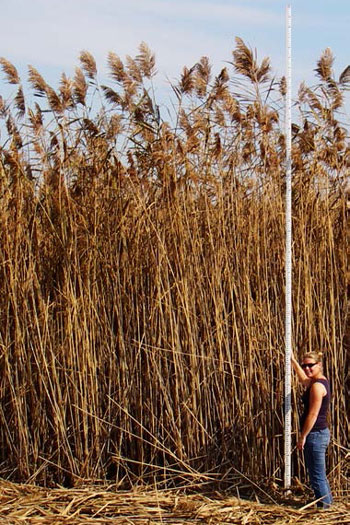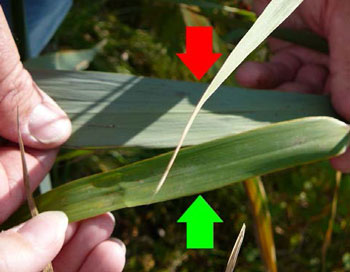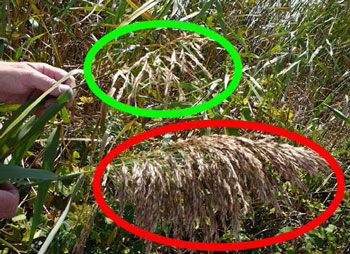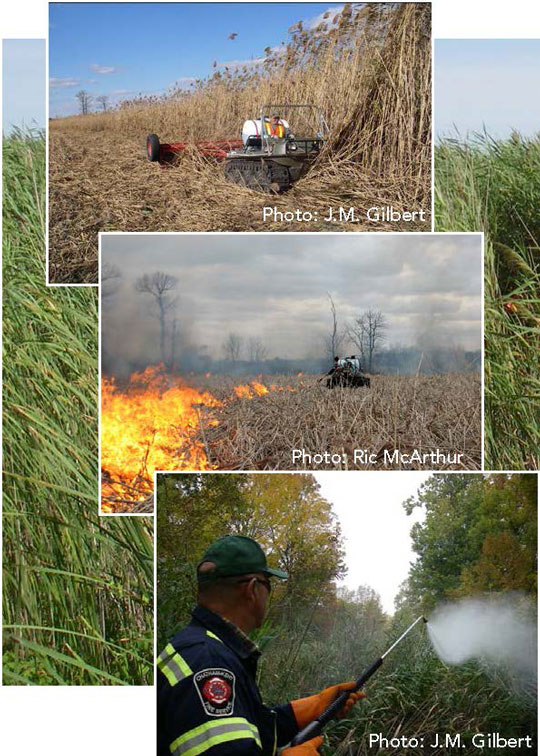Phragmites
A 2012 State of the Resource report on phragmites (European common reed), an invasive species, in Ontario
October 2012
Invasive Phragmites (European common reed) is an invasive plant causing damage to Ontario’s wetlands
What are invasive species?
Some of the plants and animals found in Ontario are not native to the province. Many of these species are harmless and may provide benefits such as food or recreational opportunities. Others, however, threaten the environment, Ontario’s economy, society, or human health. These harmful species are known as invasive species.
Invasive species have been introduced to Ontario’s lands and waters in the discarded ballast water from cargo ships and through the import of goods from other parts of the world. Invasive species often lack natural predators in their new surroundings, adapt easily to a range of environmental conditions, and reproduce at a rapid rate. These characteristics allow invasive species to quickly establish themselves in their new habitats. There are over 185 non-native species in the Great Lakes basin, including invasive species such as purple loosestrife and zebra mussels.
Invasive species can disrupt ecosystems and cause harm and stress to native species, including species at risk. Invasive species can alter food webs, affect nutrient cycling, and displace native species. These changes are often irreversible and can result in decreased biodiversity.

What is Phragmites?
Phragmites australis subspecies australis (also known as the European common reed) is an invasive perennial grass that has caused severe damage to wetlands and beaches in Ontario for several decades. It is unclear exactly how invasive Phragmites (pronounced “frag-my-teez”) was transported to North America from its native home in Eurasia. In 2005, it was identified as the nation’s “worst” invasive plant species by researchers at Agriculture and Agri-food Canada. Despite this designation, invasive Phragmites is still sold as an ornamental plant in some garden centres.
Invasive Phragmites is a very aggressive plant that spreads rapidly and out-competes native species for water and nutrients. This invasive species thrives in disturbed habitats and is often among the first species to colonize these areas. Invasive Phragmites has an intricate system of specialized roots that secrete toxins into the soil to impede the growth of and kill neighbouring plants. While invasive Phragmites prefers areas of standing water, its roots can grow to extreme lengths. These roots can also extend deep into the soil to find and access moisture, allowing the plant to survive in relatively dry areas.
Stands of invasive Phragmites reproduce primarily through the extension of runners or through the dispersal of root fragments that readily grow into new plants. Root fragments can be transported by flowing water or winds or moved around by animals. Human actions, such as the horticultural and agricultural trades or the movement of boats, trailers, and ATVs, can also disperse root fragments. Once it is established, a new invasive Phragmites plant can grow several metres in height and produce up to 2000 seeds every year.
Invasive Phragmites is closely related to the native subspecies Phragmites australis subspecies americanus. Generally, native Phragmites does not grow as tall or as densely as the invasive subspecies and does not out-compete other native species. Invasive Phragmites stands are extremely dense, with up to 200 stems per square metre, and individual plants can grow up to five metres tall. Stands of invasive Phragmites can grow so densely that they crowd out other species whereas native Phragmites grows mixed with other plants. (Figure 1).
An invasive Phragmites stand has stems that are tan or beige in colour with blue-green leaves and large, dense seedheads. Native Phragmites has reddish-brown stems, yellow-green leaves, and smaller, sparser seedheads (Figures 2, 3, and 4). A number of characteristics should be looked at to decide if the species is a native variety. In some cases, genetic analysis may be necessary to determine if the invasive subspecies of Phragmites is present.



What are the effects of invasive Phragmites?
- Invasive Phragmites grows in dense stands that crowd out native vegetation, resulting in decreased plant biodiversity.
- Generally, invasive Phragmites stands provide poor habitat and food supplies for wildlife, including several species at risk.
- Invasive Phragmites grows very quickly. Areas with stands of invasive Phragmites have lowered water levels because water is transpired at a faster rate than it would be in an area of native vegetation. This can lead to the drying of wetlands and the loss of hydrological functions such as water retention and filtering.
- Stands of invasive Phragmites are composed of a high percentage of dead stems, with a low percentage of live growth. Dead stems are dry and combustible, increasing the risk of fires.
- The stems of an invasive Phragmites stand decompose very slowly. This results in a high proportion of dead stems that slow the release of nutrients back into the ecosystem.
- Invasive Phragmites can negatively affect agriculture, lower property values, cause road safety hazards, and impact recreational activities such as swimming, boating, and angling.
What is the current status of invasive Phragmites?
Stands of invasive Phragmites can be found along roads and ditches, as well as in wetlands, beaches, marshes, and similar low-lying, wet habitats. Invasive Phragmites is currently widespread across southern Ontario. There are large stands in Lake St. Clair, Rondeau Provincial Park, Long Point Bay, and Turkey Point Provincial Park. While the boundaries of the plant’s distribution have not been determined, there is evidence that invasive Phragmites is spreading.


What is Ontario doing to help control invasive Phragmites?
In collaboration with government and non- government agencies within Canada and the U.S., the Ontario Ministry of Natural Resources is working to identify research priorities and to determine the best methods for controlling invasive Phragmites. Research is being conducted on the distribution and the rate of spread of invasive Phragmites, and the Ontario Ministry of Natural Resources is establishing methods to map invasive Phragmites across the province using satellite imagery. Best Management Practice guidelines have also been developed to help private landowners and resource managers control invasive Phragmites.
Methods used for invasive Phragmites control vary based on site characteristics and local by-law restrictions and regulations. Control techniques include mechanical excavation, flooding, pesticide application, and prescribed burning. Due to its extensive root system, a single control measure may not always be effective. Furthermore, disturbance to an area may actually increase the density and spread of the targeted stand. Integrated management plans using two or more control strategies are usually more successful. Case-by-case assessment and site-specific solutions may be required. Initial treatments of affected sites should be followed up with frequent monitoring and re-assessment, and additional treatments may be necessary. When controlling or removing invasive Phragmites, care should be taken to minimize disturbance and cause as little damage as possible to native vegetation and wildlife. It is important to note that it is very difficult to completely eradicate an invasive Phragmites stand once it has been established.
The Ontario Federation of Anglers and Hunters, in partnership with the Ministry of Natural Resources, operates the Invading Species Awareness Program. The program’s goal is to prevent and control invasive species by increasing public education through the production and distribution of educational materials and through outreach and awareness programs.
The program maintains an invasive species website (Ontario’s Invading Species Awareness Program) and hotline (
What you can do to help control invasive Phragmites
- Learn how to identify invasive Phragmites and how to avoid accidental distribution of root fragments and seeds.
- Don’t plant invasive Phragmites. Gardeners should use only native plants in their water gardens.
- Avoid leaving designated trails or entering areas containing invasive Phragmites. Disturbance to natural areas can encourage the spread of this plant. When leaving an area containing invasive Phragmites, brush off clothing and clean equipment on-site to avoid the transfer of seeds to new areas. Remove all visible portions of plants and dispose of them in the garbage.
- Don’t attempt to compost invasive Phragmites. Seeds and rhizomes can survive and grow in a compost heap. Dispose of invasive Phragmites in the garbage or at a landfill, or by drying and burning the removed stems.
- Check out the Invasive Phragmites - Best management Practices to learn more about how to control this invasive plant.

Information sources
- Ontario Invasive Plant Council
- Government of Canada Invasive Species
- Wasaga Beach Provincial Park
- Lake Huron Centre for Coastal Conservation
- Michigan Department of Environmental Quality
- Cornell University – http://www.invasiveplants.net/phragmites/ [link inactive]
- Phragmites.org
Related information
- Ontario Ministry of Natural Resources - Invasive species in Ontario
- Ontario Ministry of the Environment
- Environment Canada
- Ontario Parks
- Turkey Point Provincial Park
- Rondeau Provincial Park
- Parks Canada
- Conservation Ontario
- Great Lakes Phragmites Collaborative
- Bird Studies Canada/Long Point Waterfowl
- Ducks Unlimited
For more information
For more information on the status of Phragmites, please contact:
State of Resources Reporting
Ontario Ministry of Natural Resources
Inventory, Monitoring and Assessment Section
300 Water Street
Peterborough ON K9J 8M5
SORR@ontario.ca
State of resources reports
ISBN 978-1-4435-2067-6 Print
ISBN 978-1-4435-2068-3 PDF
ISBN 978-1-4435-2212-0 HTML